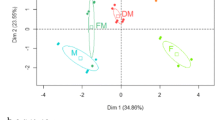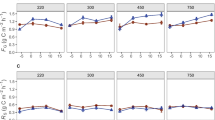Abstract
Roots and root-derived C compounds are increasingly recognised as important resources for soil animal food webs. We used 13C-labelled glucose as a model C compound representing root exudates to follow the incorporation of root-derived C into the soil animal food web of a temperate grassland over a period of 52 weeks. We investigated variations in glucose C incorporation with fertilizer addition and sward composition, i.e. variations in plant functional groups. The approach allowed the differentiation of trophic chains based on primary decomposers feeding on litter and phytophagous species feeding on roots (i.e. not incorporating glucose C) from those based on secondary decomposers feeding on microorganisms (thereby assimilating glucose C). Each of the studied soil animal species incorporated glucose C, indicating that the majority of grassland soil animal species rely on microorganisms as food resources with microorganisms being fuelled by root exudates. However, incorporation of glucose C into soil animal species varied markedly with species identity, suggesting that detritivorous microarthropods complement each other in channelling microbial C through soil food webs. Fertilizer addition markedly reduced the concentration of glucose C in most soil animal species as well as the absolute transfer of glucose C into oribatid mites as major secondary decomposers. The results suggest that fertilizer addition shifts the basis of the decomposer food web towards the use of unlabelled resources, presumably roots, i.e. towards a herbivore system, thereby lessening the link between microorganisms and microbial grazers and hampering the propagation of microbial C to higher trophic levels.


Similar content being viewed by others
References
Albers D, Schaefer M, Scheu S (2006) Incorporation of plant carbon into the soil animal food web of an arable system. Ecology 87:235–245. doi:10.1890/04-1728
Behan-Pelletier V (2003) Acari and Collembola biodiversity in Canadian agricultural soils. Can J Soil Sci 83:279–288. doi:10.4141/S01-063
Chahartaghi M, Langel R, Scheu S, Ruess L (2005) Feeding guilds in Collembola based on nitrogen stable isotope ratios. Soil Biol Biochem 37:1718–1725. doi:10.1016/j.soilbio.2005.02.006
Crotty FV, Blackshaw RP, Murray PJ (2011) Tracking the flow of bacterially derived 13C and 15N through soil faunal feeding channels. Rapid Commun Mass Spectrom 25:1503–1513. doi:10.1002/rcm.4945
Eisenhauer N, Cesarz S, Koller R, Worm K, Reich PB (2012) Global change belowground: impacts of elevated CO2, nitrogen, and summer drought on soil food webs and biodiversity. Glob Chang Biol 18:435–447. doi:10.1111/j.1365-2486.2011.02555.x
Eissfeller V, Beyer F, Valtanen K, Hertel D, Maraun M, Polle A, Scheu S (2013) Incorporation of plant carbon and microbial nitrogen into the rhizosphere food web of beech and ash. Soil Biol Biochem 62:76–81. doi:10.1016/j.soilbio.2013.03.002
Eitzinger B, Micic A, Körner M, Traugott M, Scheu S (2013) Unveiling soil food web links: new PCR assays for detection of prey DNA in the gut of soil arthropod predators. Soil Biol Biochem 57:943–945. doi:10.1016/j.soilbio.2012.09.001
Endlweber K, Ruess L, Scheu S (2009) Collembola switch diet in presence of plant roots thereby functioning as herbivores. Soil Biol Biochem 41:1151–1154. doi:10.1016/j.soilbio.2009.02.022
Ferlian O, Scheu S, Pollierer MM (2012) Trophic interactions in centipedes (Chilopoda, Myriapoda) as indicated by fatty acid patterns: variations with life stage, forest age and season. Soil Biol Biochem 52:33–42. doi:10.1016/j.soilbio.2012.04.018
Grayston SJ, Wang S, Campbell CD, Edwards AC (1998) Selective influence of plant species on microbial diversity in the rhizosphere. Soil Biol Biochem 30:369–378. doi:10.1016/S0038-0717(97)00124-7
Gruner DS, Smith JE, Seabloom EW, Sandin SA, Ngai JT, Hillebrand H, Harpole WS, Elser JJ, Cleland EE, Bracken MES, Borer ET, Bolker BM (2008) A cross-system synthesis of consumer and nutrient resource control on producer biomass. Ecol Lett 11:740–755. doi:10.1111/j.1461-0248.2008.01192.x
Haddad NM, Haarstad J, Tilman D (2000) The effects of long-term nitrogen loading on grassland insect communities. Oecologia 124:73–84. doi:10.1007/s004420050026
Harpole WS, Tilman D (2007) Grassland species loss resulting from reduced niche dimension. Nature 446:791–793. doi:10.1038/nature05684
Heidemann K, Hennies A, Schakowske J, Blumenberg L, Ruess L, Scheu S, Maraun M (2014) Free-living nematodes as prey for higher trophic levels of forest soil food webs. Oikos. doi:10.1111/j.1600-0706.2013.00872.x
Hodge A, Grayston S, Ord B (1996) A novel method for characterisation and quantification of plant root exudates. Plant Soil 148:97–104. doi:10.1007/BF00029278
Högberg MN, Briones MJI, Keel SG, Metcalfe DB, Campbell C, Midwood AJ, Hurry V, Hurry V, Thornton B, Näsholm T, Högberg P (2010) Quantification of effects of season and nitrogen supply on tree below-ground carbon transfer to ectomycorrhizal fungi and other soil organisms in a boreal pine forest. New Phytol 187:485–493. doi:10.1111/j.1469-8137.2010.03274.x
Holland JN, Cheng W, Crossley DA (1996) Herbivore-induced changes in plant carbon allocation: assessment of below-ground C fluxes using carbon-14. Oecologia 107:87–94. doi:10.1007/BF00582238
Isselstein J, Jeangros B, Pavlu V (2005) Agronomic aspects of biodiversity targeted management of temperate grasslands in Europe—a review. Agron Res 3:139–151
Jones MB, Donnelly A (2004) Carbon sequestration in temperate grassland ecosystems and the influence of management, climate and elevated CO2. New Phytol 164:423–439. doi:10.1111/j.1469-8137.2004.01201.x
Jørgensen HB, Elmholt S, Petersen H (2003) Collembolan dietary specialisation on soil grown fungi. Biol Fertil Soils 39:9–15. doi:10.1007/s00374-003-0674-6
Jørgensen HB, Johansson T, Canbäck B, Hedlund K, Tunlid A (2005) Selective foraging of fungi by collembolans in soil. Biol Lett 1:243–246. doi:10.1098/rsbl.2004.0286
Karg W (1993) Acari (Acarina), Milben. Parasitiformes (Anactinochaeta). Cohors Gamasina Leach. Raubmilben, 2nd edn. Fischer, Jena
Kempson D, Lloyd M, Ghelardi R (1963) A new extractor for woodland litter. Pedobiologia 3:1–21
Klarner B, Maraun M, Scheu S (2013) Trophic diversity and niche partitioning in a species rich predator guild—natural variations in stable isotope ratios (13C/12C, 15N/14N) of mesostigmatid mites (Acari, Mesostigmata) from Central European beech forests. Soil Biol Biochem 57:327–333. doi:10.1016/j.soilbio.2012.08.013
Koehler HH (1999) Predatory mites (Gamasina, Mesostigmata). Agric Ecosyst Environ 74:395–410. doi:10.1016/S0167-8809(99)00045-6
Langel R, Dyckmans J (2014) Combined C-13 and N-15 isotope analysis on small samples using a near-conventional elemental analyzer/isotope ratio mass spectrometer setup. Rapid Commun Mass Spectrom 28:1019–1022. doi:10.1002/rcm.6878
Larsen T, Gorissen A, Krogh PH, Ventura M, Magid J (2007) Assimilation dynamics of soil carbon and nitrogen by wheat roots and Collembola. Plant Soil 295:253–264. doi:10.1007/s11104-007-9280-y
Lemanski K, Scheu S (2014) Incorporation of 13C labelled glucose into soil microorganisms of grassland: effects of fertilizer addition and plant functional group composition. Soil Biol Biochem 69:38–45. doi:10.1016/j.soilbio.2013.10.034
Mitchell M (1977) Life history strategies of oribatid mites. In: Dindal DL (ed) Biology of oribatid mites. State University, New York, pp 65–69
Ostle N, Briones MJI, Ineson P, Cole L, Staddon P, Sleep D (2007) Isotopic detection of recent photosynthate carbon flow into grassland rhizosphere fauna. Soil Biol Biochem 39:768–777. doi:10.1016/j.soilbio.2006.09.025
Petersen U, Wrage N, Köhler L, Leuschner C, Isselstein J (2012) Manipulating the species composition of permanent grasslands—a new approach to biodiversity experiments. Basic Appl Ecol 13:1–9. doi:10.1016/j.baae.2011.10.003
Petersen U, Wrage-Mönnig N, Isselstein J (2013) Effects of herbicide application to control sward composition in different management variants. Int J Biodivers Sci Ecosyst Serv Manag 1–11. doi:10.1080/21513732.2012.760488
Pollierer MM, Langel R, Körner C, Maraun M, Scheu S (2007) The underestimated importance of belowground carbon input for forest soil animal food webs. Ecol Lett 10:729–736. doi:10.1111/j.1461-0248.2007.01064.x
Pollierer MM, Langel R, Scheu S, Maraun M (2009) Compartmentalization of the soil animal food web as indicated by dual analysis of stable isotope ratios (15N/14N and 13C/12C). Soil Biol Biochem 41:1221–1226. doi:10.1016/j.soilbio.2009.03.002
Pollierer MM, Dyckmans J, Scheu S, Haubert D (2012) Carbon flux through fungi and bacteria into the forest soil animal food web as indicated by compound-specific 13C fatty acid analysis. Funct Ecol 26:978–990. doi:10.1111/j.1365-2435.2012.02005.x
Post D (2002) Using stable isotopes to estimate trophic position: models, methods, and assumptions. Ecology 83:703–718
Post WM, Kwon KC (2000) Soil carbon sequestration and land-use change: processes and potential. Glob Chang Biol 6:317–327. doi:10.1046/j.1365-2486.2000.00308.x
Reich PB, Knops J, Tilman D, et al. (2001) Plant diversity enhances ecosystem responses to elevated CO2 and nitrogen deposition. Nature 410:809–812. doi:10.1038/35081122
Reid JP, Adair EC, Hobbie SE, Reich PB (2012) Biodiversity, nitrogen deposition, and co2 affect grassland soil carbon cycling but not storage. Ecosystems 15:580–590. doi:10.1007/s10021-012-9532-4
Rose L, Coners H, Leuschner C (2012) Effects of fertilization and cutting frequency on the water balance of a temperate grassland. Ecohydrology 5:64–72. doi:10.1002/eco.201
Ruf A, Beck L (2005) The use of predatory soil mites in ecological soil classification and assessment concepts, with perspectives for oribatid mites. Ecotoxicol Environ Saf 62:290–299. doi:10.1016/j.ecoenv.2005.03.029
Ruf A, Kuzyakov Y, Lopatovskaya O (2006) Carbon fluxes in soil food webs of increasing complexity revealed by 14C labelling and 13C natural abundance. Soil Biol Biochem 38:2390–2400. doi:10.1016/j.soilbio.2006.03.008
Sala O, Chapin F, Armesto J (2000) Global biodiversity scenarios for the year 2100. Science 287:1770–1774. doi:10.1126/science.287.5459.1770
Scheu S (2002) The soil food web: structure and perspectives. Eur J Soil Biol 38:11–20. doi:10.1016/S1164-5563(01)01117-7
Scheu S, Falca M (2000) The soil food web of two beech forests (Fagus sylvatica) of contrasting humus type: stable isotope analysis of a macro- and a mesofauna-dominated community. Oecologia 123:285–296. doi:10.1007/s004420051015
Scheu S, Folger M (2004) Single and mixed diets in Collembola: effects on reproduction and stable isotope fractionation. Funct Ecol 18:94–102. doi:10.1046/j.0269-8463.2004.00807.x
Scheu S, Simmerling F (2004) Growth and reproduction of fungal feeding Collembola as affected by fungal species, melanin and mixed diets. Oecologia 139:347–353. doi:10.1007/s00442-004-1513-7
Schneider K, Migge S, Norton RA, Scheu S, Langel R, Reineking A, Maraun M (2004) Trophic niche differentiation in soil microarthropods (Oribatida, Acari): evidence from stable isotope ratios (15N/14N). Soil Biol Biochem 36:1769–1774. doi:10.1016/j.soilbio.2004.04.033
Siemann E (1998) Experimental tests of effects of plant productivity and diversity on grassland arthropod diversity. Ecology 79:2057–2070. doi:10.2307/176709
Strickland MS, Wickings K, Bradford MA (2012) The fate of glucose, a low molecular weight compound of root exudates, in the belowground food web of forests and pastures. Soil Biol Biochem 49:23–29. doi:10.1016/j.soilbio.2012.02.001
Suding KN, Collins SL, Gough L, Clark C, Cleland EE, Gross KL, Milchunas DG, Pennings S (2005) Functional- and abundance-based mechanisms explain diversity loss due to N fertilization. Proc Natl Acad Sci USA 102:4387–4392. doi:10.1073/pnas.0408648102
Tiunov A (2007) Stable isotopes of carbon and nitrogen in soil ecological studies. Biol Bull 34:395–407. doi:10.1134/S1062359007040127
Vanderklift MA, Ponsard S (2003) Sources of variation in consumer-diet delta 15N enrichment: a meta-analysis. Oecologia 136:169–182. doi:10.1007/s00442-003-1270-z
Vitousek P, Mooney H, Lubchenco J, Melillo J (1997) Human domination of Earth’s ecosystems. Science 7:494–499. doi:10.1126/science.277.5325.494
Werner R, Bruch B, Brand W (1999) ConFlo III—an interface for high precision δ13C and δ15N analysis with an extended dynamic range. Rapid Commun Mass Spectrom 13:1237–1241. doi:10.1002/(SICI)1097-0231(19990715)13:13<1237:AID-RCM633>3.0.CO;2-C
Acknowledgments
The study formed part of the Cluster of Excellence Functional Biodiversity Research funded by the Ministry of Science and Culture of Lower Saxony and the Niedersächsisches Vorab. We thank Mark Maraun for advice on data analysis, as well as Georgia Erdmann, Christel Fischer, Bernhard Klarner and Nicole Scheunemann for help in sorting and identifying species. Special thanks to Odette Gonzalez for support in determining Collembola.
Author information
Authors and Affiliations
Corresponding author
Additional information
Communicated by Roland A. Brandl.
Rights and permissions
About this article
Cite this article
Lemanski, K., Scheu, S. Fertilizer addition lessens the flux of microbial carbon to higher trophic levels in soil food webs of grassland. Oecologia 176, 487–496 (2014). https://doi.org/10.1007/s00442-014-3037-0
Received:
Accepted:
Published:
Issue Date:
DOI: https://doi.org/10.1007/s00442-014-3037-0




